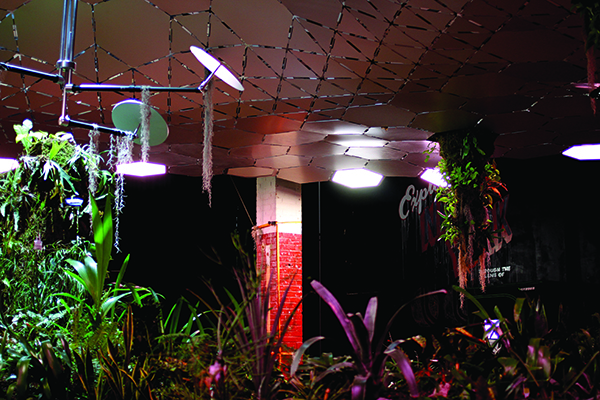JUust below Delancey Street on the Lower East Side of Manhattan lie the architectural bones of the defunct Williamsburg Bridge Trolley Terminal, opened back in 1908 and discontinued 40 years later when trolleys were no longer a mode of transportation for New Yorkers. Dubbed The Lowline, one of the most interesting aspects of the new space will be the ability to grow plants underground utilizing solar technology and proprietary LEDs.
Bringing this unique project to completion is the Lowline Lab, located nearby and the firm in charge of producing the controlled experiments to be adapted to the Lowline site. The Lowline Lab landscape – designed by Signe Nielsen of Mathews Nielsen and built by John Mini Distinctive Landscapes – is composed of 3,000+ plants, including dozens of unique varieties, spread across 1,000 square feet. The Lab’s experiments with growing plants underground will guide which types are the best to use in the park.

How do you grow plants where the sun doesn’t shine? Simple, just bring sunlight to the plants — which is easier said than done, of course. To accomplish that task using solar technology, Lowline co-founder James Ramsey and his team at Raad Studio, plus the Korea-based technology company Sunportal, designed and installed optical devices to track the sun throughout the sky every minute of every day to optimize the amount of natural sunlight that could be captured. The sunlight is then distributed into the Lowline Lab’s warehouse through a series of protective tubes, directing full spectrum light into a central distribution point. A solar canopy –
designed and constructed by engineer Ed Jacobs –
spreads the sunlight out across the space, modulating and tempering the sunlight, and providing the necessary light needed to sustain the plant life.
LED manufacturer Lighting Science is collaborating with Lowline Lab to develop custom LED grow lighting for The Lowline park, which is roughly the size of a football field. “Lighting Science’s groundbreaking LED indoor grow lighting positions them as a leader in their field and the perfect collaborative partner for the Lowline Lab,” says James Ramsey.
Fueled by their shared passion for pushing the boundaries of design and technology, Lighting Science’s team worked with the Lowline Lab engineers last year to develop, donate, and install 24 adjustable LED lights into the 1,000-sq.-ft. suspended aluminum canopy at The Lowline Lab. Each hexagonal panel is roughly two feet in diameter and features three settings: one that provides soft-white light, one that mimics daylight, and one that includes Lighting Science’s patented VividGro™ LED indoor grow light spectrum technology.
Tailored to the indoor agriculture and horticultural markets, VividGro’s patented light spectrum has reportedly been proven to increase plant yields by up to 30 percent, increase the nutritional density of crops by approximately 10 to 12 percent, and decrease energy consumption by up to 45 percent or more.
“It’s wonderful getting involved with a group of passionate people to do something new and of great value,” adds Fred Maxik, founder and Chief Technology Officer of Lighting Science and inventor of VividGro. “Our job – fitting light into novel forms and functions – complements their amazing vision of bringing closed urban environments to vivid life with light.”
Filled with more than 3,500 plants, the Lowline Lab installation also uses experimental technology that harnesses the power of natural sunlight through funnel-like solar installations that magnify and direct beams of sunlight to the underground plant life.
By combining the power of VividGro LED panels and the Lowline Lab’s “Remote Skylight” technology, co-founders James Ramsey and Dan Barasch were able to achieve the right light intensity, duration, and spectrum necessary for a wide range of flowers, plants, fruits, and vegetables to thrive even on the darkest winter day. “You know you’re onto something when you can grow pineapples and tomatoes during a New York winter underground,” Ramsey comments.
The accomplishments of The Lowline Lab has sparked conversations about new ways that cities and communities around the world can reclaim abandoned urban spaces. For example, by discovering how to create a sustainable environment for a subterranean ecosystem, the Lowline has been able to develop new solutions for providing a public space that can be enjoyed all year long, regardless of the season.
Set to open in 2021, the Lowline will be the world’s first underground park, one that New York Magazine called “the most exciting civic project since The High Line [see sidebar].” A larger and more ambitious evolution of the Lowline Lab experiment, the Lowline park will comprise 40,000 square feet and will be under the guidance of James Ramsey and Dan Barasch. It will feature a diverse range of flora and fauna that will experience natural photosynthesis without direct access to sunlight. Ramsey and Barasch hope The Lowline will provide new technology solutions for indoor agriculture and sustainably grown local food production.
The Lowline was approved by the City of New York in August, and the eyes of urban leaders around the world will be watching as The Lowline is transformed into a subterranean botanical garden and cultural attraction. In addition to Lighting Science, The Lowline is also working in partnership with the international engineering firm Arup, the architecture firm RAAD, the renowned landscape architecture firm Matthew Nielsen, and horticulturalists John Mini Distinctive Landscapes.
The Lowline Lab is open to the public on the weekends, having welcomed 100,000 visitors so far. During the weekdays, it hosts a Young Designers Program, offering educational sessions in Science, Technology, Engineering, Arts, and Mathematics (STEAM) to nearly 3,000 children and serves as a youth mentorship and job training site for 16 Young Ambassadors. The goal is to have the community become engaged with the project and to inspire people of all ages and backgrounds to study and understand the transformative power of innovation.





